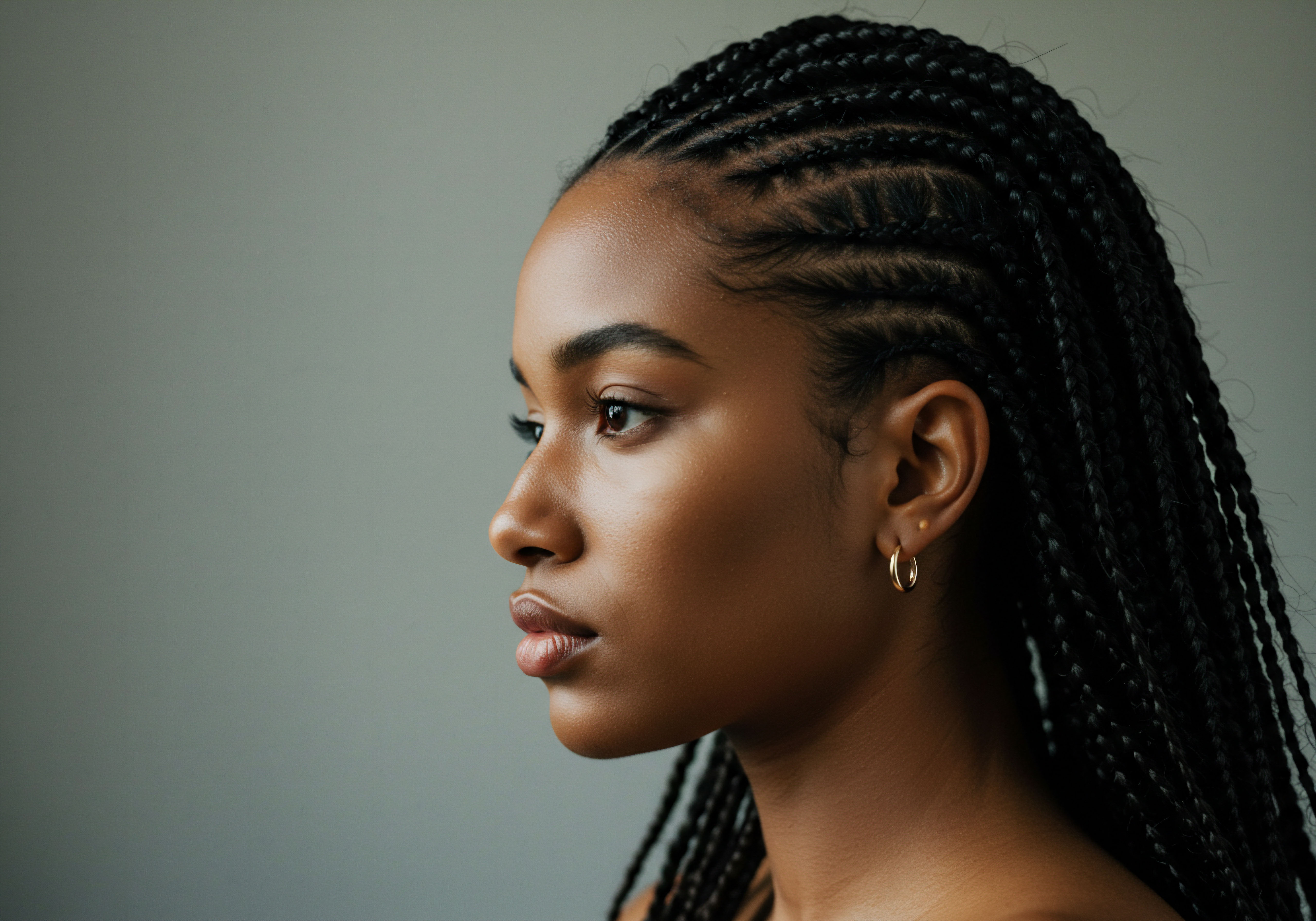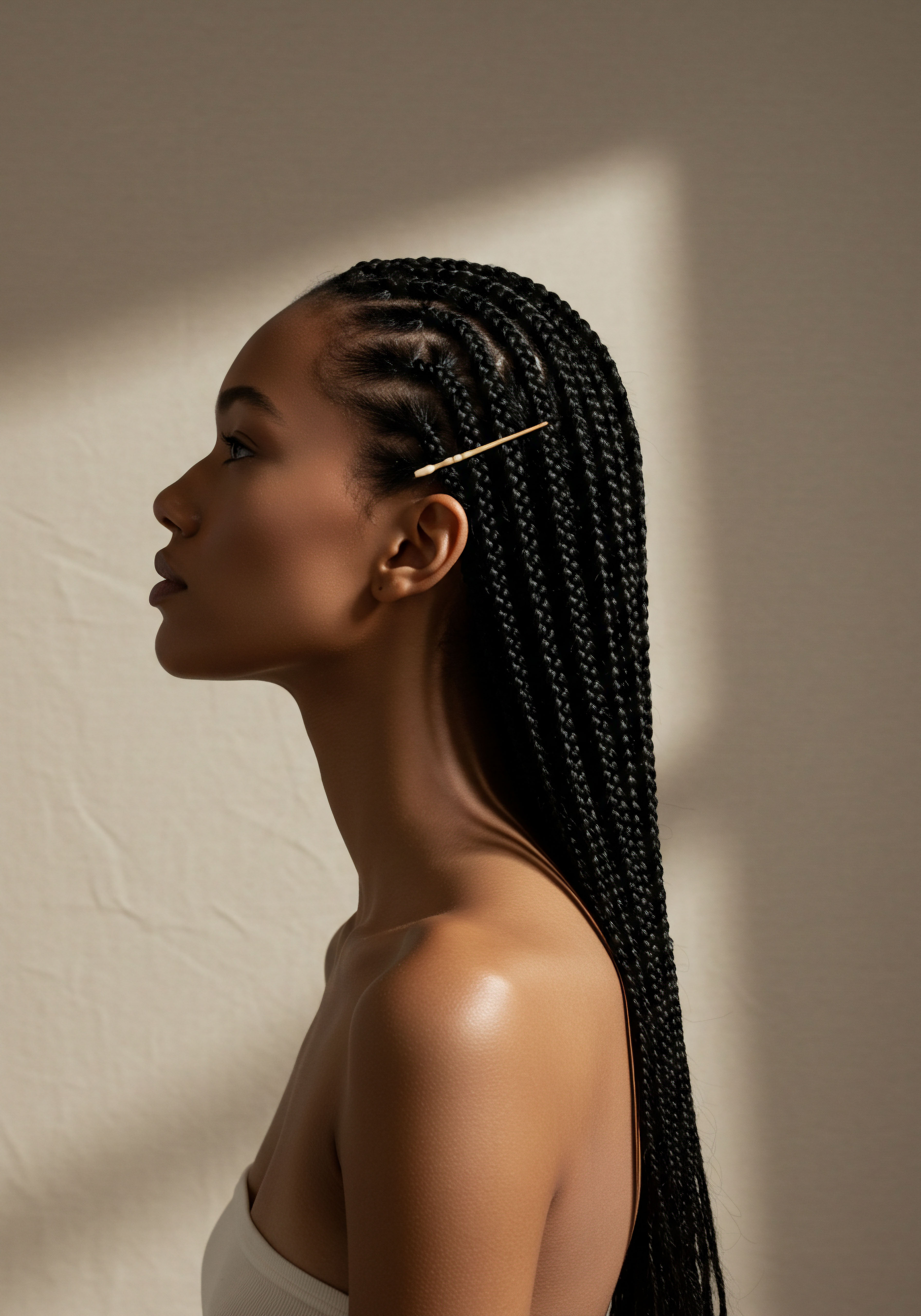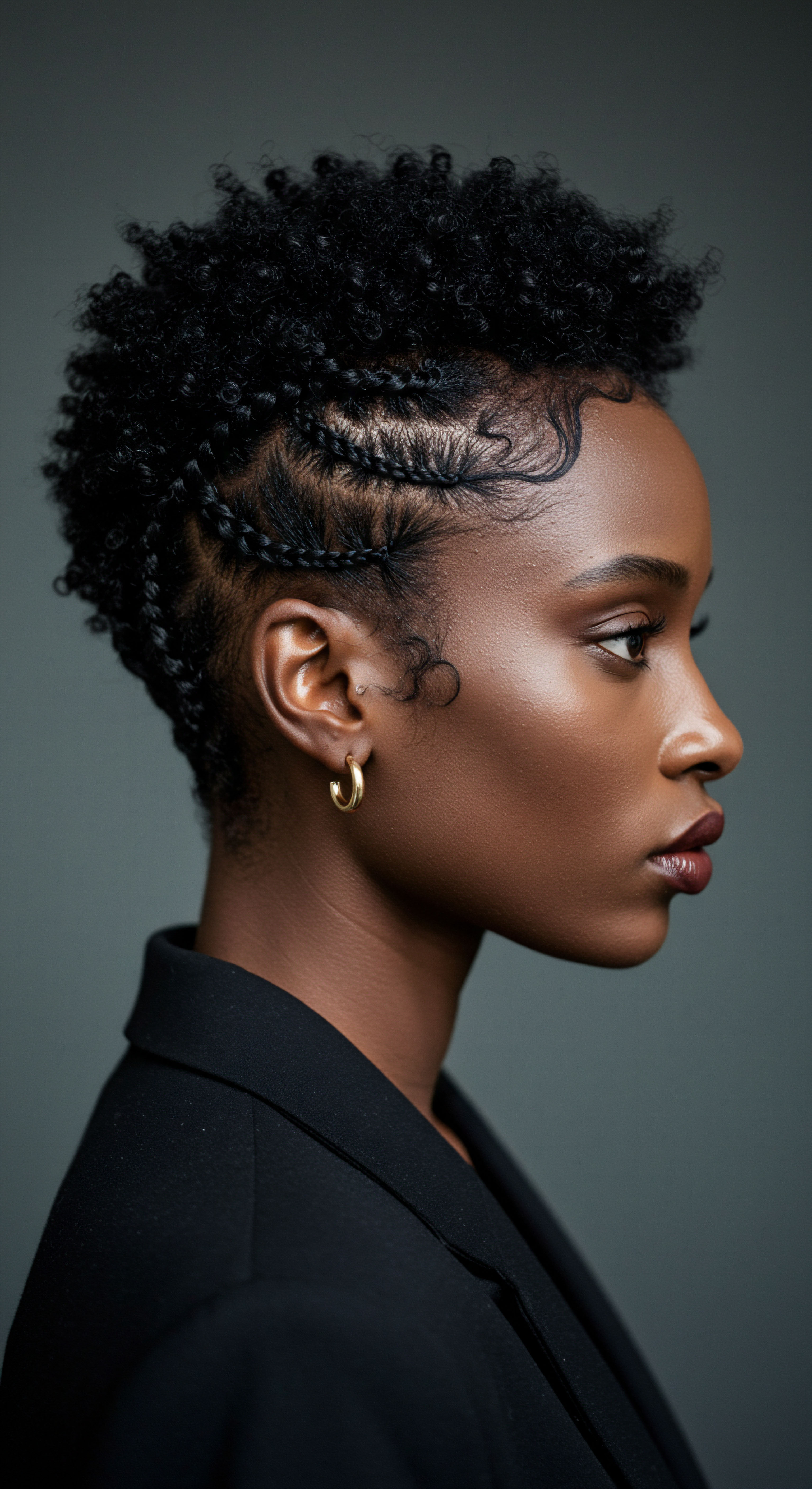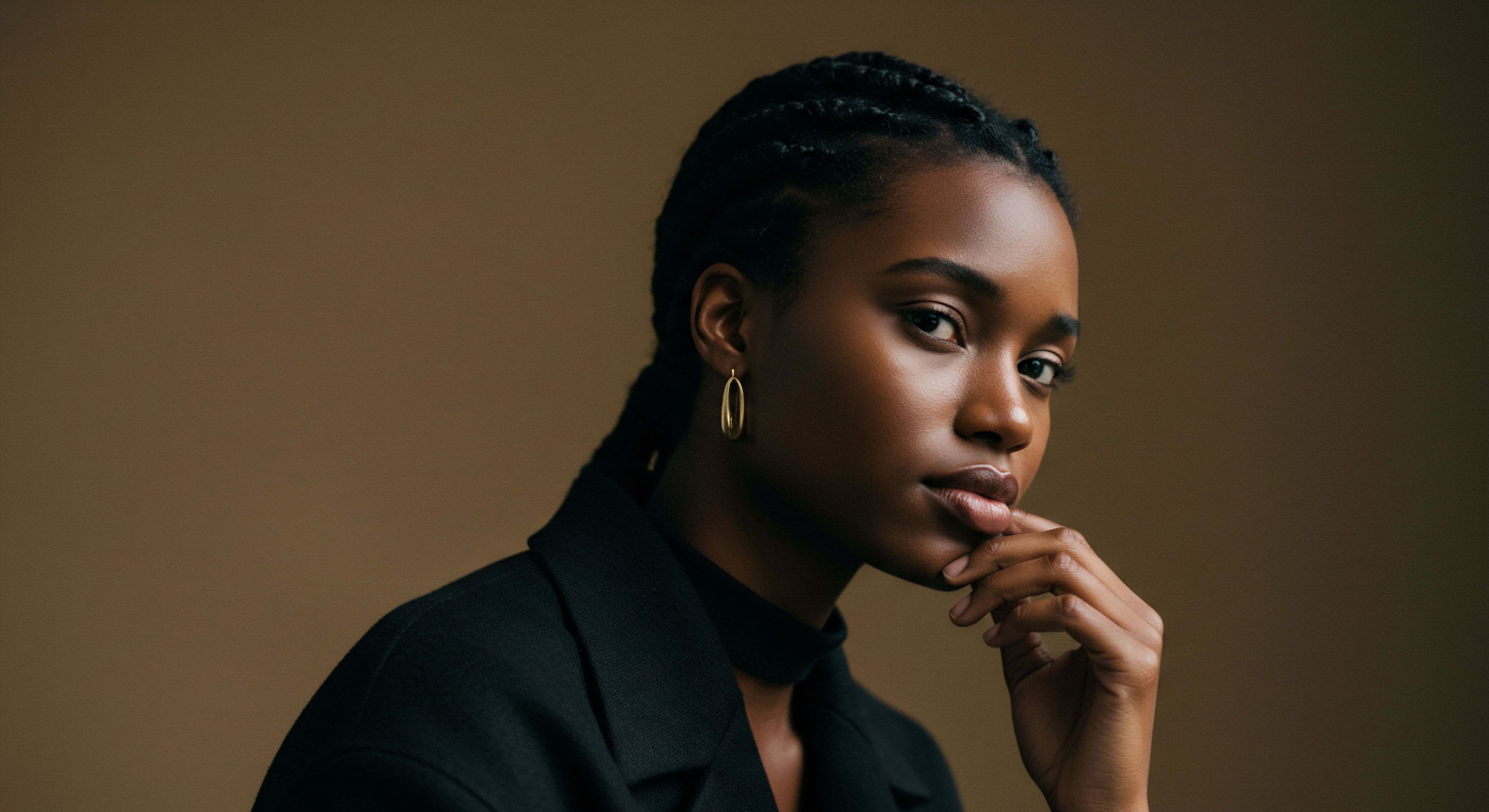
Roots
Hair, in its myriad forms, has always been more than mere adornment. It holds stories, whispers of lineage, and echoes of survival. For those with textured hair, this connection runs particularly deep, often serving as a visible testament to resilience and cultural heritage.
The question of what historical hairstyles protected natural hair opens a doorway to understanding not only ingenious methods of care but also the profound social and spiritual significance intertwined with each strand. It invites us to consider how our ancestors, with remarkable ingenuity and profound respect for their crowns, safeguarded their hair against the elements and the rigors of daily existence, laying down practices that continue to resonate today.

The Architecture of Natural Hair
To truly appreciate the protective nature of historical styles, one must first understand the unique architecture of textured hair. Unlike straight hair, which tends to be round in cross-section, coily and curly strands are often elliptical or flattened. This structural distinction, combined with fewer cuticle layers that lay flat, means textured hair possesses a natural propensity for dryness and can be more susceptible to breakage if not handled with gentle consideration.
The very curl pattern itself, with its twists and turns, creates points where moisture can escape more readily and where tangles might form. Recognizing these inherent characteristics was, for our ancestors, the genesis of styles designed to mitigate such challenges, allowing hair to thrive in diverse climates and conditions.
Historical protective styles for natural hair served as a testament to ingenuity, preserving strands from environmental stressors and the demands of daily life.

How Does Hair Porosity Shape Its Needs?
Hair porosity, the hair’s ability to absorb and retain moisture, plays a significant role in its overall health and how it responds to care. For individuals with High Porosity Hair, the cuticle layers are often raised, allowing moisture to enter and exit with ease. This can lead to rapid drying and a tendency toward frizz. Conversely, Low Porosity Hair has tightly bound cuticles, making it more resistant to moisture absorption but also excellent at retaining it once hydrated.
Historically, while the scientific terminology was absent, ancient communities instinctively understood these variations. They developed practices that intuitively addressed the unique needs of different hair types, often through the consistent application of natural oils and butters, and the use of styles that shielded the hair from harsh environmental factors. For instance, high porosity hair particularly benefits from protective styles that help seal in moisture.
Understanding hair’s intrinsic nature, from its curl pattern to its porosity, formed the silent, yet powerful, scientific foundation upon which generations built their hair care traditions. This knowledge was not written in textbooks but passed down through hands, through observation, and through the shared experience of nurturing a living crown.

Early Protective Styles and Their Cultural Echoes
The earliest forms of protective styling date back millennia, with evidence pointing to African civilizations as pioneers. Braids, for example, trace their origins to 3500 BC in African culture, serving not only a practical purpose but also conveying a wealth of social information.
- Braids ❉ These intricate designs communicated tribal affiliation, marital status, age, wealth, and even religious beliefs. The act of braiding itself was often a communal activity, fostering social bonds and transmitting knowledge from elders to younger generations.
- Twists ❉ Similar to braids, twists provided a way to keep hair neat and protected without needing bands or products to hold them. They too held symbolic meaning, denoting tribe, social status, and family background.
- Bantu Knots ❉ Originating from the Zulu people and tracing back to the 2nd millennium BC during the Bantu migration, these coiled buns were both a protective style and a symbol of cultural identity, with the term “Bantu” universally translating to “people” across many African languages.
- Locs ❉ In some African societies, locs symbolized strength and were reserved for warriors or priests, connecting wearers to higher powers.
These styles were not merely aesthetic choices; they were living languages, speaking volumes about the wearer’s place in the world. They protected the hair from the sun, wind, and dust, minimizing manipulation and breakage. This ancient wisdom, rooted in observation and a deep connection to the environment, offers profound lessons for modern hair care.

Ritual
Stepping from the quiet wisdom of hair’s fundamental nature, we arrive at the realm of daily practice—the rituals that transformed raw understanding into tangible care. For centuries, the rhythms of life dictated the rhythms of hair care, not as a burdensome chore, but as a purposeful act of preservation and connection. These historical approaches offer a gentle guide, reminding us that true hair health blossoms from consistent, thoughtful attention, rather than quick fixes. It invites us to consider how the techniques and tools of the past, often born of necessity and passed through generations, continue to shape our modern approach to protecting natural hair.

The Daily Practice of Protection
Historical protective styles were a daily reality for many, reflecting an intuitive understanding of hair’s needs long before scientific laboratories. The core idea was to minimize external stressors ❉ sun, wind, dust, and the constant friction of daily activities. By securing the hair, often close to the scalp, these styles reduced tangling, breakage, and moisture loss. This practice was particularly vital in arid climates or during periods of intense physical labor, where exposed hair would quickly become dry, brittle, and damaged.

How Did Historical Practices Reduce Hair Manipulation?
One of the primary ways historical styles protected hair was by reducing mechanical manipulation. Daily combing, brushing, and styling can cause friction and breakage, especially for delicate textured strands. By securing hair in styles that could last for days, weeks, or even months, ancient communities dramatically lowered the frequency of such stressors.
Consider the widespread use of braids and twists across African cultures. Once installed, these styles allowed the hair to remain tucked away, shielding the ends—the oldest and most fragile part of the hair—from environmental damage and daily handling. This deliberate reduction in manipulation is a cornerstone of modern protective styling, directly contributing to length retention.
Protective styling, deeply rooted in historical practices, minimizes manipulation and shields hair from environmental stressors, promoting length retention.
Beyond braids and twists, other forms of hair concealment, such as head wraps and turbans, also served a protective role. While often chosen for cultural or aesthetic reasons, these coverings provided an additional layer of defense against the elements, maintaining moisture and preventing physical damage. In West African societies, hair wraps, with their varied prints and colors, also served to symbolize tribe or social status, alongside their practical function of keeping hair healthy and guarding against heat damage.

Ancient Tools and Ingredients
The tools and ingredients used in historical hair care were primarily derived from nature, reflecting a symbiotic relationship with the surrounding environment. These natural resources provided the necessary nourishment and lubrication for hair that would be styled and kept for extended periods.
| Ingredient Castor Oil |
| Historical Region of Use Ancient Egypt, West Africa |
| Primary Protective Benefit Moisture, strengthening, scalp health |
| Ingredient Shea Butter |
| Historical Region of Use West Africa |
| Primary Protective Benefit Deep conditioning, environmental shield, moisture |
| Ingredient Olive Oil |
| Historical Region of Use Ancient Greece, Rome, Egypt |
| Primary Protective Benefit Nourishment, shine, scalp health |
| Ingredient Coconut Oil |
| Historical Region of Use India (Ayurveda) |
| Primary Protective Benefit Moisture, protein loss prevention, damage reduction |
| Ingredient Jojoba Oil |
| Historical Region of Use Indigenous cultures |
| Primary Protective Benefit Scalp care, mimics natural sebum |
| Ingredient Rhassoul Clay |
| Historical Region of Use Morocco |
| Primary Protective Benefit Cleansing, detoxifying scalp without stripping |
| Ingredient Herbal Rinses |
| Historical Region of Use Medieval Europe, various cultures |
| Primary Protective Benefit Scalp health, shine, strengthening |
| Ingredient These natural ingredients formed the bedrock of ancient hair care, addressing specific needs through their inherent properties. |
The practice of Hair Oiling, deeply rooted in traditions from India (Ayurveda) to West Africa, was a sacred ritual passed through generations. Oils and butters were applied to keep hair moisturized, particularly in hot, dry climates, and were often paired with protective styles to maintain length and health. This tradition of regular oiling and moisturizing, combined with low-manipulation styles, created a powerful synergy for hair preservation.
Beyond topical applications, historical communities also understood the internal connection to hair health. While not always explicitly documented in terms of specific styles, the general emphasis on holistic well-being, including diet and herbal remedies, indirectly supported hair vitality. This comprehensive approach, addressing both external protection and internal nourishment, paints a vivid picture of hair care as a ritualized practice, rather than a fleeting trend.

Relay
Having considered the deep roots of hair’s structure and the gentle cadence of historical rituals, we now turn to a more expansive view, one that connects ancient practices to contemporary understanding, recognizing the subtle interplay of culture, science, and resilience. The inquiry into historical protective styles for natural hair expands beyond mere technique; it asks us to see how ingenuity, necessity, and cultural identity converged, creating a legacy that continues to resonate with profound relevance. This section will delve into the complexities of this heritage, examining the scientific underpinnings of traditional methods and their enduring social impact.

Cultural Resilience and Hair’s Hidden Meanings
The historical adoption of protective hairstyles often transcended simple practicality; it became a powerful act of cultural assertion and survival, particularly for people of African descent. During periods of immense adversity, such as the transatlantic slave trade, hair became a canvas for defiance and coded communication. Enslaved people, stripped of so much, continued to style their hair in ways that honored their ancestry and even aided their fight for freedom.
For instance, historical accounts indicate that cornrows were used as literal maps to freedom, with patterns braided into the hair serving as guides for escape routes. Rice grains were sometimes braided into the hair for sustenance during arduous journeys. This transformation of hair from a mere physical attribute into a tool of resistance and a repository of knowledge speaks volumes about the depth of its cultural meaning. These styles were not simply about hair protection; they were about protecting identity, hope, and survival.
Beyond physical preservation, historical protective hairstyles became symbols of cultural identity, resistance, and encoded communication during periods of oppression.
The resilience of these traditions is evident in their continuation despite centuries of attempts to suppress them. Laws like the 18th-century Tignon Law in Louisiana, which forced Black women to cover their hair, underscore the perceived threat that Black hair and its styling posed to prevailing social hierarchies. Yet, the traditions persisted, re-emerging powerfully during movements like the Black Power era, where the Afro hairstyle became a symbol of Black pride and a rejection of Eurocentric beauty standards. This ongoing dialogue between hair, identity, and societal pressures highlights the enduring, multifaceted role of protective styles.

Scientific Underpinnings of Length Retention
While ancient practitioners may not have articulated their methods in terms of modern trichology, their practices align remarkably with current scientific understanding of hair health. The core benefit of protective styles for natural hair, particularly highly textured hair, lies in their ability to promote Length Retention. Hair grows, on average, about half an inch per month, regardless of styling. The challenge for textured hair often lies in retaining that growth, as its structure makes it prone to breakage.
Protective styles achieve length retention through several key mechanisms:
- Reduced Mechanical Manipulation ❉ Daily combing, brushing, and styling can cause friction and breakage. When hair is tucked away in braids, twists, or buns, it is subjected to significantly less handling, allowing it to grow undisturbed.
- Environmental Shielding ❉ Exposure to harsh sun, wind, and dry air can strip hair of moisture and lead to damage. Protective styles act as a physical barrier, shielding the hair from these external aggressors.
- Moisture Preservation ❉ Textured hair is often naturally dry. Protective styles, especially when paired with moisturizing products, help to seal in hydration, reducing dryness and making the hair less brittle and prone to breakage.
A critical aspect of protective styling, often overlooked in popular discourse, concerns the potential for harm if not executed thoughtfully. While braids and other styles are beneficial for length retention, improper installation or prolonged wear can lead to hair loss, specifically Traction Alopecia. This condition arises from excessive tension on the hair follicles. A 2022 review of hairstyling trends among Black women, drawing from PubMed and EMBASE, found that while natural styles generally had the fewest adverse associations, all traction hairstyles, including braids and twists, carried a risk for traction alopecia.
The study further indicated that cumulative use of such styles was associated with Central Centrifugal Cicatricial Alopecia (CCCA), underscoring the necessity for careful practice. This highlights a crucial balance ❉ the protective benefits are maximized when tension is minimized, and styles are not left in for excessive periods.

The Interconnectedness of Hair, Identity, and Wellness
The journey through historical hair practices reveals a profound truth ❉ hair care has rarely been a solitary, superficial act. It is a deeply social and personal endeavor, intertwined with identity, community, and well-being. The communal act of styling hair, seen in ancient African societies where braiding sessions were opportunities for bonding and storytelling, continues to resonate today. This collective approach fostered a shared understanding of hair care and reinforced cultural ties.
The shift from traditional practices, often rooted in natural elements and community support, to chemically altered styles during periods of forced assimilation or societal pressure, speaks to the power structures that have historically impacted hair choices. The ongoing movement to celebrate natural hair, often utilizing modern interpretations of these historical protective styles, is a testament to a reclamation of identity and a renewed appreciation for hair’s inherent beauty and strength. This modern resurgence of protective styles is not merely a fashion statement; it is a continuation of a legacy of self-preservation, cultural pride, and a holistic approach to hair wellness.

Reflection
As we close our exploration of historical hair styles that protected natural hair, we find ourselves standing at a quiet confluence of past and present. The wisdom of ancestors, once whispered through generations, now finds echoes in scientific understanding. From the intentional twists of ancient Egyptian braids to the resilience embodied in cornrows during times of oppression, hair has consistently served as a guardian of both physical strands and cultural spirit.
The story of protective styling is not a relic of a bygone era; it is a living, breathing testament to human ingenuity, adaptation, and an enduring reverence for one’s natural self. It reminds us that care, in its deepest sense, is a continuum, stretching from the earliest human hands to our own, inviting us to honor this profound heritage as we continue to nurture our crowns today.

References
- Chimbiri, K.N. (2022). Crowning Glory ❉ A History of African Hair Tradition. Self-published.
- Dabiri, Emma. (2019). Twisted ❉ The Tangled History of Black Hair Culture. Harper Perennial.
- Byrd, Ayana. (2001). Hair Story ❉ Untangling the Roots of Black Hair in America. St. Martin’s Press.
- Flowers, Ebony. (2019). Hot Comb. Drawn and Quarterly.
- Ibhawoh, Olunosen Louisa. (2022). CROWNING GLORY ❉ A history of African hair tradition. Self-published.
- Jackson, L. T. (2022). Afro-Ethnic Hairstyling Trends, Risks, and Recommendations. MDPI.
- Patton, Tracey Owens. (2006). Hair Matters ❉ Beauty, Power, and Black Women’s Consciousness. Rutgers University Press.
- Walker, Madam C.J. (1928). Text Book of the Madam C.J. Walker Schools of Beauty Culture.